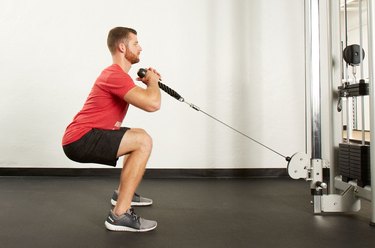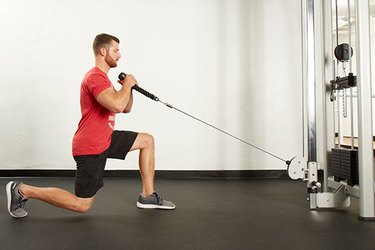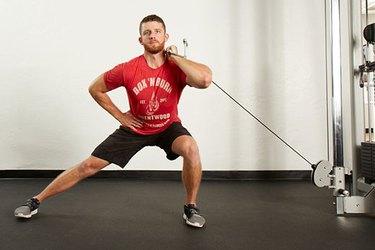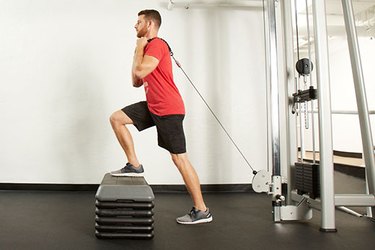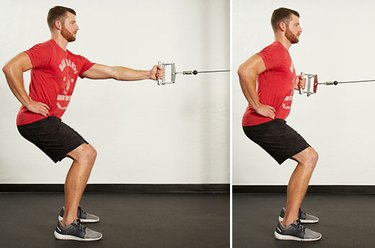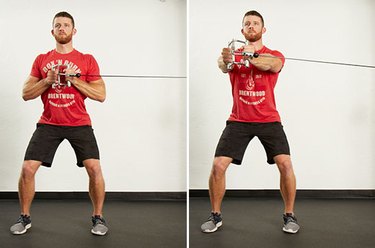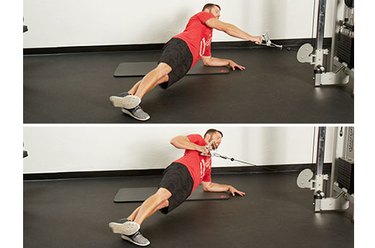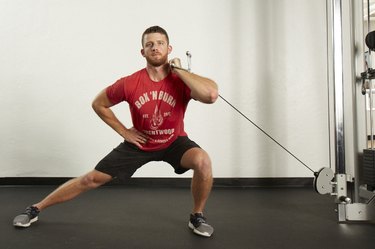
Looking for a different way to gain strength and boost power? Try the cable machine. You can add this piece of resistance equipment to just about any exercise to help build strength in a non-traditional way. Plus, it's an all-in-one workout so you won't waste time wandering around the gym from machine to machine.
These 13 cable exercises, which are divided into three categories based on the muscles they target, will help you become leaner, stronger and more athletic. Perform them as a single training session or add a few of them to your current program.
Video of the Day
Video of the Day
Tip
Before you add the resistance of the cable to any exercise, master correct form with just your body weight.
Lower-Body Cable-Machine Exercises
Traditional lower-body exercises such as squats, lunges, deadlifts and step-ups become much more challenging when you add the pull of a cable. The cable provides a horizontal force that tries to pull your body from its center of gravity, demanding more core muscles to work, stabilize and strengthen to prevent you from falling over.
Note that with all of these exercises, you'll have to start by pulling the cable out, which applies tension. You should stand far enough away so that the weight stack does not "bottom out" at the end of the exercises. Avoid letting the weight stack smash into itself.
Shop the Best Cable Machines for Your Home Gym
- Mikolo Fitness Lat and Lift Pulley System, Dual Cable Machine ($69.99, Amazon.com)
- BodyBoss 2.0 Full Portable Home Gym Collapsible Resistance Bar and Bands ($169, Amazon.com)
- Bowflex Home Gym Series ($799, Amazon.com)
- XMark Functional Trainer Cable Machine With Dual 200-Pound Weight Stacks ($2,650, Amazon.com)
1. Cable Front Squat
- Begin facing the cable machine with the pulley on the lowest setting (as close to the floor as possible).
- Using a rope attachment, grip the rope with your thumbs toward the ceiling — the goblet grip position.
- Pull up the rope so it's just below your chin with your elbows bent.
- Don't allow the rope to drop as you descend into a squat by sitting your hips back and keeping your knees out and feet shoulder-width apart (or just outside).
- Don't allow your back to round or overarch as you push through your heels to return to standing.
2. Cable Forward Lunge
- Begin facing the cable machine with the pulley on the lowest setting and the rope in the goblet-grip position.
- With your feet hip-width apart and your core tight, take a step toward the cable, keeping your hips level and knees and ankles in line as you descend into a lunge. Keep your knee from diving out in front of your toes. Make sure to stand up straight and avoid leaning forward.
- Push the ground away and return to the starting position.
- Repeat with the other leg while keeping your core tight.
- Continue alternating sides.
Tip
During this movement, the cable will try to pull you forward but use your core strength to keep your back from rounding or overarching.
3. Cable Reverse Lunge
- With the cable pulley on the lowest setting, grip the rope attachment so the pinky sides of your hands are in contact with the knobs of the rope.
- Carefully turn away from the cable machine while bringing the rope into the "suspenders position," over your shoulders as if it were a set of suspenders.
- With your feet hip-width apart, take a step back as you carefully descend into a reverse lunge.
- Dig your front-leg heel into the ground and return to the starting position.
- Repeat with the other leg and continue alternating sides.
Tip
During this movement, the cable will try to pull you down and back, so start from a solid athletic position (hips slightly back and knees soft). Tightening your core and keeping your back straight will also help prevent you from moving down and back.
4. Cable Lateral Lunge
- Begin facing sideways to the cable with the pulley at the lowest setting.
- With a D-handle attachment, bring your hand up to your shoulder to the racked position.
- Step away from the cable and with the feet hip-width apart and pointing forward, brace your core to stand straight and tall.
- Next, take a step toward the cable into a lateral lunge.
- Push yourself back to the starting position and repeat.
- Turn around and do the same facing the other direction.
Tip
Don't allow the cable to pull your upper body out of line with your knee as you sit your hips back and descend into the lunge.
Read more: 22 New Lunges to Supercharge Leg Day
5. Cable Step-Up
- Get a box (or low step) and place it a few feet in front of the cable machine.
- Start facing away from the cable with the pulley at the lowest setting and the rope attachment in the suspenders position.
- Place one foot on the box, making sure your heel is firmly on the box. This will help ensure you don't fall and are working your glutes. Your knee should be at roughly 90 degrees.
- Keep your hips level, core tight and the foot, knee and hip of your standing leg in line.
- Dig your heel into the box as you step up, bringing the other foot to the top of the box.
- Step back down with the same leg and repeat before switching legs.
Tip
Keep the working leg on the box until all reps are complete to maintain greater stability.
Upper-Body Cable-Machine Exercises
The cable can also be used to add intensity, core stability and power to upper-body exercises by working from various positions that target your muscles differently. Start with some tension on the cable and get ready to work your chest, shoulders, back and arms.
6. Split-Stance Single-Arm Cable Chest Press

- Using the D-handle attachment, place the handle in your right hand and step away from the cable.
- Face away from the cable with the pulley at lower-chest height.
- Next, take a step back with your right leg to assume a static lunge position (split stance).
- With your arm by your side at 90 degrees, there should be tension on the cable.
- Brace your core and keep your hips level as you press the cable away from the body without allowing the body to move or rotate.
- Complete all your reps one side before switching arms.
Tip
If the weight is too light, the cable will “snap” at the end of the press and won't feel smooth. Increase the weight until the motion is smooth throughout.
7. Split-Stance Single-Arm Shoulder Press
- As with the chest press, begin facing away from the cable in a split stance.
- Keeping your core braced and hips forward, press the cable overhead so your arm finishes just in front of your ear. Don't let the arm travel behind your head, which puts the shoulder at risk for injury, or let the cable cause you to overarch your back.
- Keep your core tight throughout the entire range of motion.
- Lower back down to the start with control.
Tip
With both of the pressing exercises, you can increase the difficulty by performing the exercise from an athletic position (feet side by side).
8. Single-Arm Cable Row
- With the cable pulley at lower-chest height, face the machine and grasp the D-handle with one hand.
- Take a few steps back from the cable and assume an athletic position (half squat).
- Row the cable back without allowing your core to move or hips to rotate. Focus on bringing the shoulder blade straight across your upper back toward your spine, followed by the arm.
- At the end of the row, don't let your elbow finish behind the body or your shoulder tip forward.
- Repeat on the same side before switching to the other arm.
9. Half-Kneeling Single-Arm Cable Pulldown

- Begin by placing the cable pulley at the highest setting with the D-handle attachment.
- Facing the cable, grab the handle with your right hand.
- Take a step back with your right leg and place your right knee on the ground.
- With your left knee up so that both legs are at 90 degrees, make sure your knees and ankles are in line. At this point, your arm should be overhead with tension on the cable.
- Keeping your abs tight, pull the handle down so your hand finishes at shoulder height with the elbow at the side of the body. Don't let your elbow finish behind your body or your shoulder tip forward at the end.
- Repeat and switch sides.
10. Biceps Curl

- Begin with the cable pulley will be at the lowest setting.
- With the rope attachment, hold the ropes in your hands, thumbs pointing up.
- Keeping your elbows close to your sides, curl the handle up.
- Lower back down to the start.
11. Triceps Pushdown
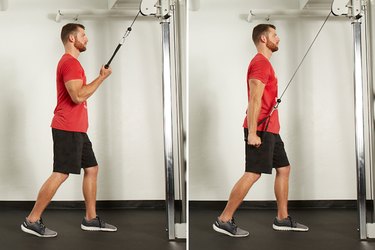
- Place the cable at the highest setting with the rope attachment.
- Holding the rope in both hands, keep the elbows close to your sides.
- Bracing your core to avoid hunching over, press the cable down, squeezing your triceps at the bottom.
- Release back up to the top with control.
Core Cable-Machine Exercises
While every exercise so far trains the core due to the nature of the cable machine, the following exercises are designed to specifically challenge core stability, strength and stamina. The key is to not allow your body to move while the cable tries to make your core rotate, bend or round. Perform these exercises and feel your core working to the max.
Read more: 12 Weight-Training Mistakes You Don't Want to Make
12. Anti-Rotation Press
- With the cable pulley at lower-chest height, begin sideways to the cable machine.
- Grasp the D-handle attachment with both hands and bring the handle to the center of the chest.
- From an athletic position (half squat) with your feet just outside hip-width, press the cable straight out from the chest.
- Hold the handle out for two seconds before bringing it back to starting position.
- Repeat before turning around and completing the exercise facing the other direction.
Tip
The pull from the cable will place a rotational force on the body, but the goal is to not allow your hands to be pulled toward the cable or allow your body to rotate toward the cable. You want to feel steady throughout. To increase intensity, bring your feet closer together.
13. Side-Plank Cable Row
- Adjust the cable pulley to the lowest setting with the D-handle attachment.
- From a side-plank position, face the cable so the pulley is level with your lower chest.
- Grasp the handle with the top hand (the other arm is on the ground as a base).
- Next, row the cable handle toward your body.
- Repeat on one side before switching to the other.
Tip
This move is challenging, so start with a lighter weight and complete all your reps without allowing your body to rotate or your hips to sag. During the row, your body will want to rotate toward the cable, but don’t allow this to happen. By bracing your core, you should prevent your body from moving as you row the cable.
